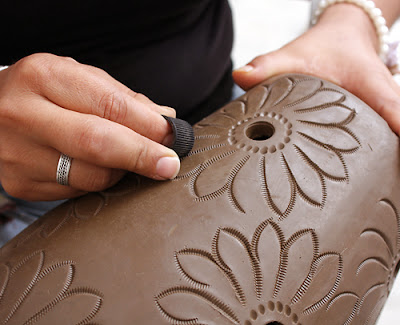Clay Tools
Believe it or not, your finger is one of your best clay tools.
It's great for pinching, poking, pulling and smoothing the clay.
Preschoolers
Here are some good tools for little hands when exploring and creating with play doughs.
1. Spatula for cutting and scraping clay off surfaces
2. Blunt scissors to cut the clay
3. Roulette for making wiggly lines into the clay
4. Rolling pin for flatting clay
5. Standard set of sculpting tools made of plastic for making marks
Beginners
Here are the simplest tools that I recommend for beginners working with clay.
Most of these you probably have in your home already.
They are all you need to help you get started working with clay.
1. Popsicle stick -for cutting and poking
2. Tongue depressor -for making notches
3. Pointed dowel -for drawing
4. Plastic knife -for cutting
5. Plastic fork -for making line patterns
6. Tooth brush -for scoring clay
7. Kitchen sponge -for smoothing clay
8. Plastic dish- for water
Advanced
If you want to step it up a notch, try these.
1. Scratch-Art tool - has a small needle on the end to draw thin lines. Available at: https://www.dickblick.com
2. Kemper Potters Needle - used to score and cut the clay. Available at: https://www.baileypottery.com
3. Drawing tool - one excellent tip for drawing lines and the other tip for smoothing clay. Available at:https://activaproducts.com
4. Felting Knife - used for cutting clay. Available at: https://www.baileypottery.com
5. Box Wood tool - used for creating lines - great for making a furry texture on animals. Available at: https://www.baileypottery.com
6. Metal fork - used for making line patterns.
7. Scratch Wire Brush - used for making scoring lines when joining clay pieces together. Available at: https://www.baileypottery.com
8. Flat brush - used for applying slip.
9. Paint cup - used for holding water. This type is great because it comes a with brush/tool holder lip.
10. Natural sponge - has a great shape and holds up longer than a synthetic sponge.
Rolling pins are great for flattening clay. They come in different widths and lengths. Most are made out of wood because the clay doesn't stick to the surface. The ones with the ball bearings in the handle (1) are the easiest to roll back and forth with. Extra large rolling pins purchased from a ceramic supplier work well when flatting large slabs of clay for big projects for art students. Smaller sized rolling pins (3) work best for children's little hands. You can make your own by just using a wooden dowel (2).
To help make slabs evenly rolled or a certain thickness you can use dowels (1) of various dimensions on either side of your clay. The dowels will keep the clay from thinning out too much. Available at: your local hardware store. You can also purchase a leveled clay roller kit (2) like this one at: https://activaproducts.com
Slab rollers make rolling out clay a cinch, but are super expensive. Mostly art teachers and ceramic potters own them.
Rolling pins are even available in different textures.
These are Texture Wheels.
Cotton Duck cloth - used as a messy mat and to keep clay from sticking to the table top surface. It can be stretched onto a board to make moving around clay projects easier. Available at: Walmart and JoAnn's in the fabric section.
Here are some great add on tools to have in your tool box.
1. Roulette tool - used to roll wavy lines into the clay. Available at: https://www.hobbylobby.com
2. Loop tool - used to carve out clay. One with a flat and round end gives you more options. Available at: https://www.baileypottery.com
3. Fondant tools - these have some unusual tips and make great impressions. Available at: https://www.hobbylobby.com
4. Cleaning tool - used for scraping bone dry clay pieces. Good for cleaning up edges.
5. Hole cutter - used for carving out holes in clay. These come in various dimensions. Available at: https://www.baileypottery.com
6. Ball Stylus - used for pushing in round holes into the clay and shaping forms. Available at: https://www.baileypottery.com
This a great Potter's Starter Kit and is reasonably priced. I bought mine in college and I still have it 30 years later! Available at: https://www.baileypottery.com
These are Scoring Tools and they all work great! It all comes down to a matter of preference on which one to use.
1. Scratch Wire Brush
2. Scratch-Art tool
3. Scoring Tool available at: https://www.theceramicshop.com
4. Steel Scraper Ovoid available at: https://www.baileypottery.com
I LOVE these sponges! They are shaped like a traditional Kidney tool and fit in your hand great. They come in different absorbencies which makes them nice for smoothing surfaces.
Cookie cutters make great tools when you are trying to cut out uniform shapes.
You can make a simple circle cutter by using a can.
A clay slicer makes dividing clay into slabs super easy.
Available at: https://www.dickblick.com
Found objects make great tools too!
So just look around your house for interesting stuff. You never know what could make a great clay tool.

























